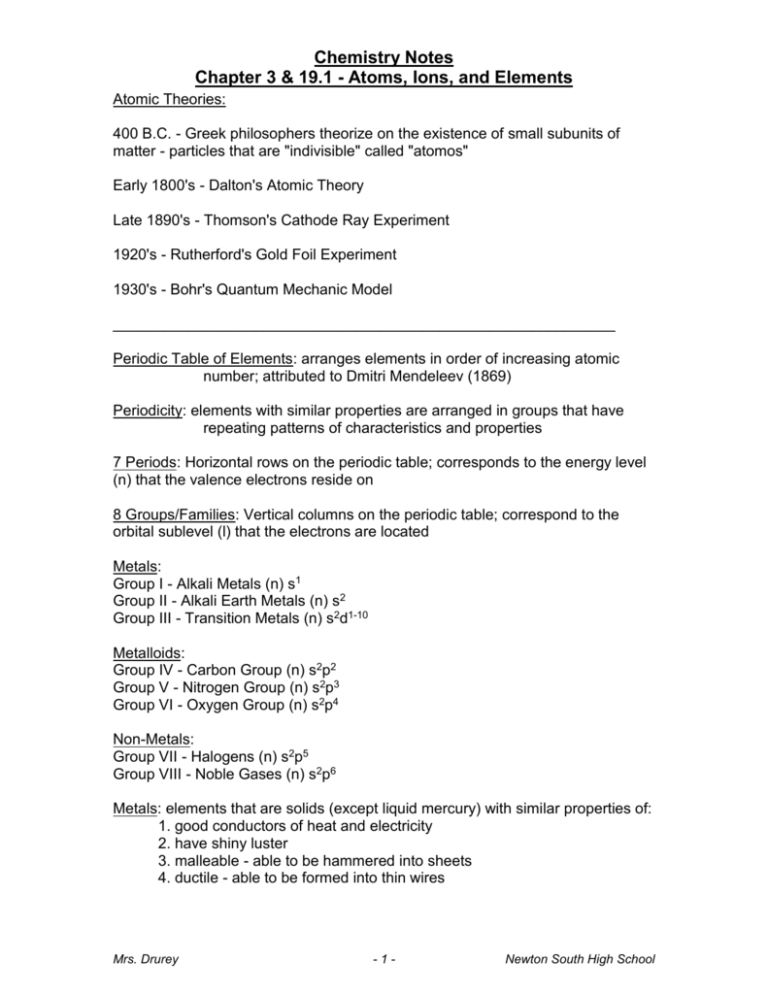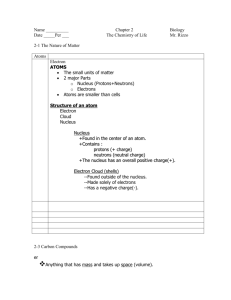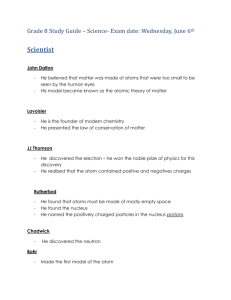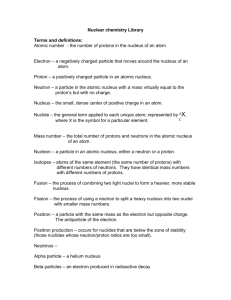Periodic Table of Elements: arranges elements in order of
advertisement

Chemistry Notes Chapter 3 & 19.1 - Atoms, Ions, and Elements Atomic Theories: 400 B.C. - Greek philosophers theorize on the existence of small subunits of matter - particles that are "indivisible" called "atomos" Early 1800's - Dalton's Atomic Theory Late 1890's - Thomson's Cathode Ray Experiment 1920's - Rutherford's Gold Foil Experiment 1930's - Bohr's Quantum Mechanic Model ____________________________________________________________ Periodic Table of Elements: arranges elements in order of increasing atomic number; attributed to Dmitri Mendeleev (1869) Periodicity: elements with similar properties are arranged in groups that have repeating patterns of characteristics and properties 7 Periods: Horizontal rows on the periodic table; corresponds to the energy level (n) that the valence electrons reside on 8 Groups/Families: Vertical columns on the periodic table; correspond to the orbital sublevel (l) that the electrons are located Metals: Group I - Alkali Metals (n) s1 Group II - Alkali Earth Metals (n) s2 Group III - Transition Metals (n) s2d1-10 Metalloids: Group IV - Carbon Group (n) s2p2 Group V - Nitrogen Group (n) s2p3 Group VI - Oxygen Group (n) s2p4 Non-Metals: Group VII - Halogens (n) s2p5 Group VIII - Noble Gases (n) s2p6 Metals: elements that are solids (except liquid mercury) with similar properties of: 1. good conductors of heat and electricity 2. have shiny luster 3. malleable - able to be hammered into sheets 4. ductile - able to be formed into thin wires Mrs. Drurey -1- Newton South High School Chemistry Notes Chapter 3 & 19.1 - Atoms, Ions, and Elements 5. high tensile strength - able to resist breaking when pulled apart 6. very reactive, even with oxygen in the air Ex. - Fe + O2 ----- Fe2O3 Iron (metal) + oxygen (gas) ---- iron III oxide (rusted metal) Metalloids: "semi-metals" - elements that have properties of both metals and non-metals 1. All solids at room temperature 2. less malleable than metals, but not as brittle as non-metals 3. good semi-conductors of electricity - used in computer chips, digital screens, T.V., electronics Non-metals: elements that are gases (except liquid bromine, solid carbon, phosphorous, selenium, sulfur and iodine) and have similar properties of: 1. Poor conductors of heat and electricity 2. dull and have no luster 3. brittle and non-malleable 4. non-ductile 5. generally non-reactive (except Group VII - Halogens - these are the most reactive non-metal group) ___________________________________________________________ Diatomic Molecules: natural elements that exist as 2 atoms (H2, O2, N2, F2, Cl2, Br2, I2) Atomic number: the number of protons in the nucleus of an atom Mass number: the total number of protons and neutrons in the nucleus of atom Cations: Positively charged ions *When an atom loses an electron, it becomes more positively charged* Mg ----- Mg2+ + 2eNeutral magnesium atom loses 2 electrons to become magnesium cation Anions: Negatively charged ions *When an atom gains an electron, it becomes more negatively charged* Cl + e- -------- ClNeutral chlorine atom gains 1 electron to become chloride anion Isotopes: Atoms with the same number of protons, but different numbers of Neutrons *Atoms cannot change the number of protons without changing their identity* Mrs. Drurey -2- Newton South High School Chemistry Notes Chapter 3 & 19.1 - Atoms, Ions, and Elements Radioactive Decay - the spontaneous decomposition of a nucleus to form another nucleus; atomic number and mass number are conserved Alpha particle - helium nucleus produced in radioactive decay (heavy radioactive nuclide) Beta particle - radioactive nuclide decay that produces no change in mass number, decreases atomic number by 1 Gamma particle - high-energy photon of light Positron - same mass as electron, opposite in charge Electron capture - inner-orbital electrons captured by the nucleus Nuclear transformation - changes one atom into another by particle bombardment Geiger counter - detects radioactivity by using argon gas that becomes ionized by rapidly moving, high-energy particles from radioactive decay Scintillation counter - detects radioactivity when high-energy particle strikes sodium iodide crystal and gives off light that can be measured Half-life - time required for half of a sample to decay from its original amount Radiocarbon or carbon-14 dating - objects that contain carbon can be dated by measuring their carbon-14 : carbon-12 ratio Fusion - combining 2 lighter nuclei of atoms to form a heavier nucleus Fission - splitting of a heavy nucleus into 2 lighter nuclei Mrs. Drurey -3- Newton South High School








